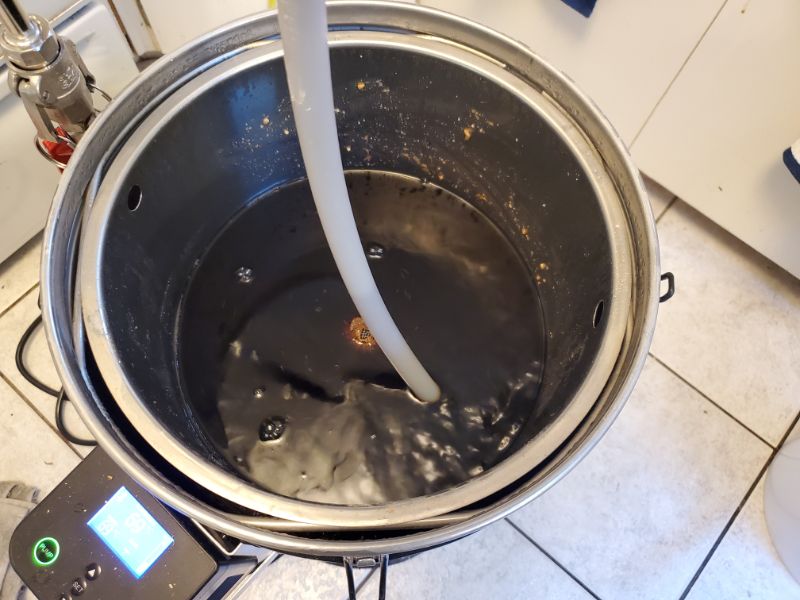An oatmeal stout recipe, quick-fermented with Voss Kveik yeast and named with a pun.
Originally Posted: Sept. 24, 2020

Table of Contents
Quick Specs
- Est. OG = 1.048
- OG = 1.053 – 1.055
- Est. FG = 1.016
- FG = 1.014
- ABV: 4.9% – 5.4%
- Taste Profile: Nice and roasty, with a milder roasty flavor from the Midnight/Chocolate Wheat
- Time: 3 days fermenting, a few days for kegging/carbonation
- Yield: 1 Corny keg
Intro
I’m a big fan of dark, roasty beers. One of the first beers I truly enjoyed for its flavor was a Guinness I had at age 19 during a college trip up to Canada. Later on I found that dark lagers were the only lagers I consistently enjoyed; I remember having a few pints of Köstritzer at a pub specializing in German beers in the U-district before sitting in on a late O-chem class with a friend.
The very first homebrewed beer I worked on was a milk stout. We bought a Brew In A Bag (BIAB) milk stout kit and brewed it in my mom’s 32-quart tamale steamer over a Bayou Classic propane burner in the back yard. The next stout I brewed was also based on a milk stout, but with an ABV boosted to barleywine levels with some caramelized honey: my Bochet Braggot Stout.
However, my taste in alcohol has trended towards dryer drinks over the last ten years, so I began asking myself why I hadn’t brewed a dry stout. I also became more interested in brewing more sessionable brews around this time. After looking into some recipes, the one that stood out to me was Oatmeal Stout. I found a recipe that looked like a good starting point and built around that based on ingredients I had on hand.
Brief History
There is a long history of using oats in beer, both as a fermentable and as a contributor to mouthfeel. Trappist monks brewed a table beer for travelers that was mainly made of malted oats (from Brew Like a Monk).
What we call oatmeal stout in modern times became popular during the late 19th Century. These early oatmeal stouts—like the later milk stout—were advertised for the reputed health benefits that oats added to the beer.
Ingredients
Malt
- 7 lbs. Maris Otter malt
- 1 lb. Crystal 10°L
- 1.5 lbs. Munich malt
- 8 oz. Midnight Wheat or Chocolate Wheat malt
- 8 oz. Chocolate malt
- 12 oz. Rolled oats (I usually just buy those big ~2 lb. cannisters of quick oats at the grocery store)
- 11.25 lbs. grain total
Hops/Other
- 1.25 oz. Kent Goldings @ 60min.
- 1 tsp. Gypsum (can be added anytime during the boil. Some people even add it to the mash. Could warrant further experimentation in the future)
- Whirlfloc and Yeast Nutrient @ 15 min.
- 1 oz. Kent Goldings @ 10 min.
Yeast
Equipment
- Sanitizer
- Fermenter
- Airlock and stopper (a thermowell stopper works well for temperature control)
- Your choice of brewing system (I use Grainfather all-in-one)
- DIY temperature control system

Early mash 
Mid-mash 
Late mash 
Spent grain after sparging.
Instructions
- Mash at desired temperature for 1 hour. This is a fun one to experiment with mashing temperatures: I’ve mashed this one at 155°F (68°C) during the first attempt and 145°F (63°C) for the second just to see if there was a noticeable difference in mouthfeel.
- Note: I’ve added gypsum before the mash and in the last 15 minutes of the boil. There doesn’t seem to be much of a difference in what time you add the gypsum, but I think I prefer to add it before the mash rather than during the boil, to more closely emulate traditional water chemistry.
- Follow hop/nutrient schedule above.
- Chill wort and add your choice of yeast. Follow recommended fermentation times and temps for your yeast (I prefer Voss kveik at 95°F (35°C) because it ferments completely in about 2 – 3 days).
- Keg or bottle condition.


Variations
Since this beer has become one of my regular rotations, I’ve decided to also use the recipe as a base beer for several other more complex beers. I’d like to try it out as a quick-soured stout, a pumpkin spice stout, and a black IPA in the future.
Tips & Tricks
Despite Midnight Wheat malt being a wheat, it doesn’t provide as much head retention as flaked wheat does. I suspect the roasting process destroys some of the proteins responsible for head retention, so if you like your stouts with a lot of head I’d recommend throwing in a handful of flaked wheat.



